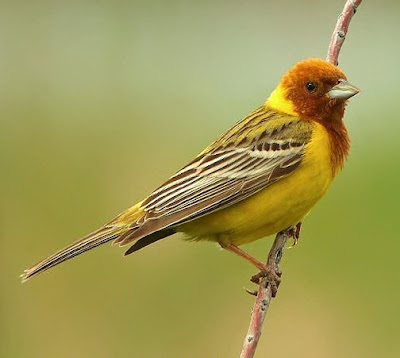Emberiza bruniceps
 |
| Photo by Audevard Aurelien (Mango Verde) |
Common name:
red-headed bunting (en); escrevedeira-de-cabeça-ruiva (pt); bruant à tête rousse (fr); escribano de cabeza roja (es); braunkopfammer (de)
Taxonomy:
Order Passeriformes
Family Emberizidae
Range:
This species is found breeding in central Asia, from southern Russia and Kazakhstan to northern Iran and Afghanistan. They migrate south to winter in India.
Size:
These birds are 16-17 cm long and have a wingspan of 25-28 cm. They weigh around 25 g.
Habitat:
Red-headed buntings are found in open habitats, such as grasslands and steppes, scrublands, semi-desertic areas and oasis, and also in arable land. They occur from sea level up to an altitude of 2.000 m.
Diet:
They feed on the ground, mainly eating seeds and other plant material, but during the breeding season insects and other invertebrates become an important part of their diet.
Breeding:
Red-headed buntings breed in May-July. The nest is a loose structure made of cereal stems and grasses, placed close to the ground in a dense or thorny shrub, vine or fruit tree. The female lays 3-6 eggs, which she incubates alone for 10-14 days. The chicks fledge 2 weeks after hatching.
Conservation:
IUCN status - LC (Least Concern)
This species has a very large breeding range. There is no information on population size, but the population is suspected to be stable in the absence of evidence for any declines or substantial threats.
No comments:
Post a Comment